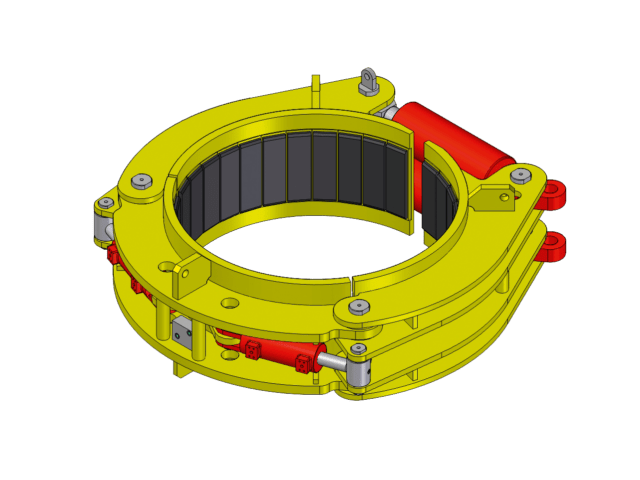In the world of foundation construction, where stability, precision, and safety are paramount, even the smallest components can have a significant impact on overall performance. One such often-overlooked yet crucial component is the pile driver clamp. These mechanical devices serve as a critical link between the pile and the driving equipment, ensuring that the pile is securely held during installation.
This article explores the essential role of pile driver clamps in foundation construction, examining their function, benefits, types, and why they are indispensable to any successful pile driving operation.
Understanding Pile Driver Clamps
Pile driver clamps are mechanical gripping devices designed to securely hold piles in place during the driving process. Whether attached to a vibratory hammer, impact hammer, or hydraulic press, these clamps ensure that the pile remains steady and properly aligned as it is driven deep into the ground.
Without effective pile driver clamps, the pile could slip, rotate, or misalign—leading to uneven load-bearing capacity, construction delays, and even structural failure. In essence, they serve as the hands of the pile driving system, gripping each pile firmly during one of the most critical phases of construction.
Why Pile Driver Clamps Matter in Modern Construction
1. Precision and Stability
Proper alignment is vital in pile driving, especially for load-bearing foundations. Misaligned piles can lead to reduced structural integrity and costly repairs. Pile driver clamps ensure that the pile is aligned correctly before and during driving, helping operators maintain precision even under challenging soil or weather conditions.
This precise handling results in vertical and accurate pile placement, which contributes to the long-term stability and safety of the structure.
2. Improved Safety on the Job Site
Job site safety is a top priority in every construction project. Improperly secured piles can shift or fall, putting workers and equipment at risk. By securely gripping the pile during driving, pile driver clamps reduce the chance of accidents caused by slippage or uncontrolled movement.
Additionally, many modern clamps feature quick-release mechanisms and ergonomic designs that minimize the manual labor required, further lowering the risk of injury during setup or removal.
3. Adaptability to Various Pile Types
Construction projects today utilize a wide range of pile materials—steel, concrete, timber, and even composite piles. These materials come in varying shapes and sizes, from round to square to sheet piles. Pile driver clamps are designed to adapt to these different forms, offering universal compatibility or specialized solutions for specific pile types.
This flexibility makes them invaluable for contractors working across multiple job sites with differing foundation requirements.
Types of Pile Driver Clamps
There are several types of pile driver clamps available, each suited to different applications and machinery:
• Universal Clamps
These are designed to accommodate a wide range of pile shapes and sizes. Their versatility makes them a preferred choice for general contractors who need a reliable, adaptable clamping solution.
• Pipe Pile Clamps
Engineered specifically for cylindrical piles, these clamps offer superior grip and load distribution, reducing the risk of pile deformation or slippage during driving.
• Sheet Pile Clamps
Used for installing interlocking sheet piles, these clamps help maintain correct orientation and interlock integrity, which is essential for applications like retaining walls and cofferdams.
• Custom or Hydraulic Clamps
Some pile driver clamps are powered hydraulically and provide automated gripping and releasing. These are ideal for high-production environments where efficiency and repeatability are key.
Material Durability and Design Considerations
Given the high forces involved in pile driving, pile driver clamps must be constructed from durable materials such as high-strength steel and equipped with wear-resistant components. Many also feature hardened gripping jaws to ensure a firm hold without damaging the pile surface.
Design considerations include load capacity, ease of maintenance, resistance to environmental conditions (especially in marine or offshore applications), and compatibility with the driving equipment being used.
Investing in high-quality clamps ensures long service life and reliable performance, reducing downtime and repair costs.
Maintenance and Inspection
Like all equipment used in foundation construction, pile driver clamps require regular inspection and maintenance. Operators should routinely check for wear on gripping surfaces, hydraulic leaks (if applicable), and proper operation of locking mechanisms.
Scheduled maintenance not only extends the lifespan of the clamp but also ensures safe and consistent performance throughout the project lifecycle.
Economic and Operational Benefits
While clamps might seem like a small component in the overall scheme of a pile driving system, their influence on productivity and cost-efficiency is significant. By preventing delays, minimizing equipment damage, and reducing the need for corrective actions, pile driver clamps contribute to smoother operations and more predictable outcomes.
Moreover, the time saved by using reliable clamps—particularly quick-change or hydraulic variants—translates to lower labor costs and increased job site throughput.
Conclusion
In foundation construction, success depends on both the strength of the materials used and the precision of the installation. Pile driver clamps may not be the most visible tools on a construction site, but their role is indispensable. They ensure that every pile is placed securely, safely, and accurately—forming the foundation upon which all else is built.
